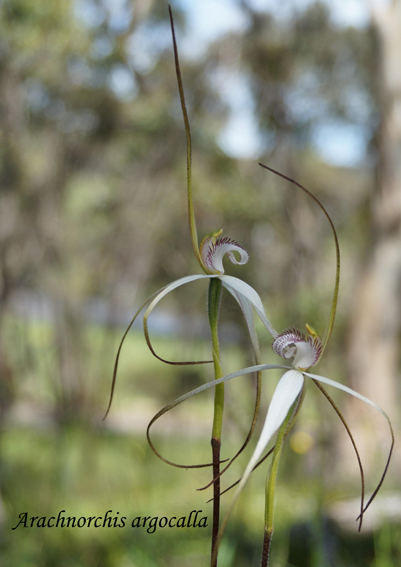Tag: Caladenia flava
2016 Orchid Picture of the Year
For the final meeting of the year we chose the best of the 2016 monthly winners of the picture competition.
Here in Australia we are fortunate to have such a variety of orchids. They may not be as big and showy as some of the overseas orchids but the diversity of shapes fires the imagination as reflected in this year’s monthly winners, when put together. The common names of the winners – spider, leopard, flying duck, cowslip, zebra, helmet, bluebeard and greenhood – reinforce this theme of diversity.
Patterns and colours contribute to the variety of our orchids. Australian orchid colours run the gamut of the rainbow and more, with Australia being home to most of the naturally occurring blue orchids in the world. This colour fascinates and allures people around the world so much so that nurseries will dye a white orchid blue because it will sell. There is even a website devoted to the colour called, not surprisingly, Blue Orchid and the popular band master Glenn Miller wrote a song titled Blue Orchids (1944).
Could this be why the very clear winner for the year was Claire Chesson’s Pheladenia deformis common name Bluebeard or Blue Fairy?

Claire Chesson on your most beautiful picture.
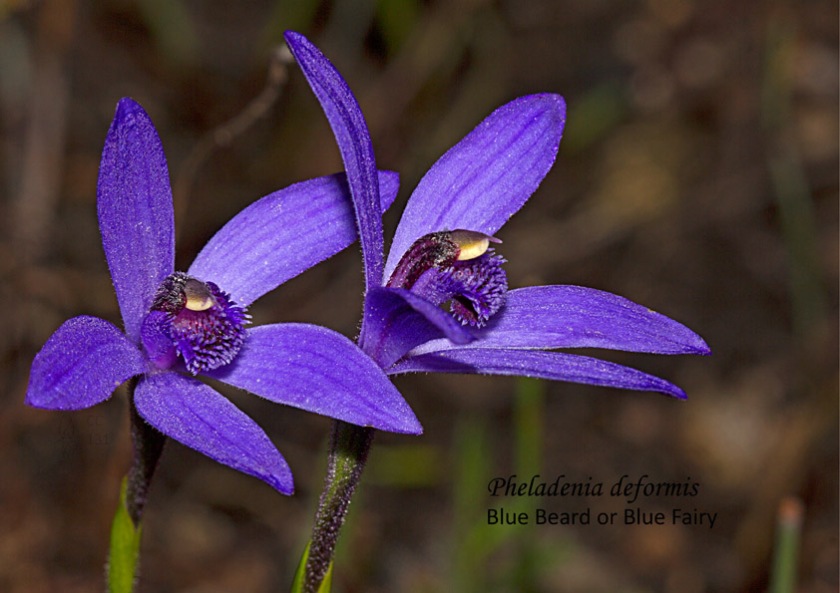
Claire won the August competition.
As a reminder, below are the other winners for the year. Click on the image to see the related articles.
February 2016 Photographer: Pauline Meyers

March 2016 Photographer: Judy Sara
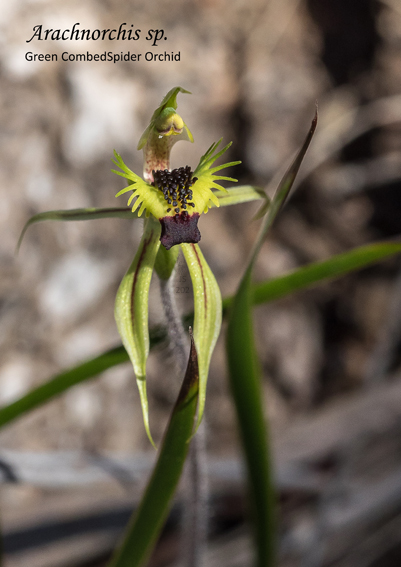
April 2016 Photographer: Claire Chesson
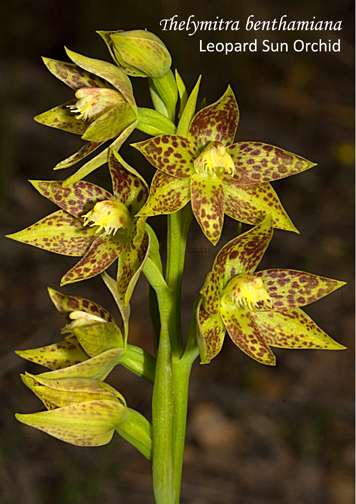
May 2016 Photographer: Pauline Meyers
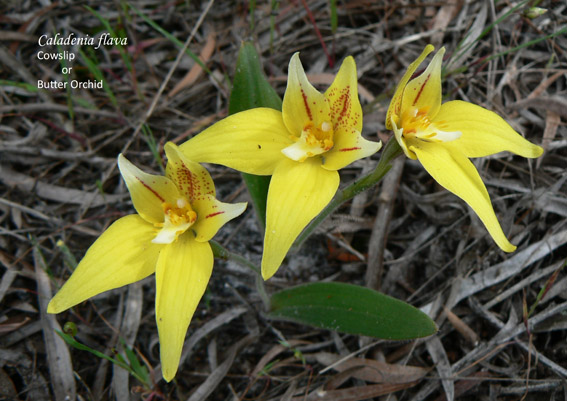
2016 June Photographer: Ros Miller
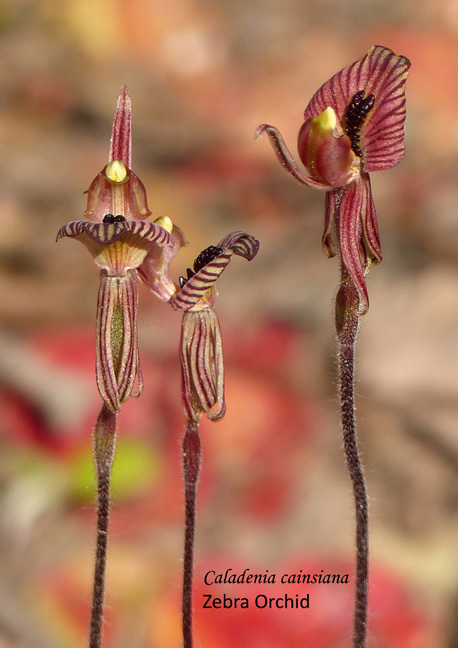
2016 July Photographer: Robert Lawrence
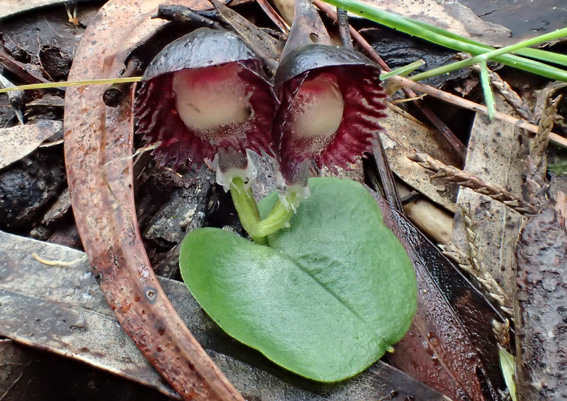
2016 September Photographer: Bevin Scholz
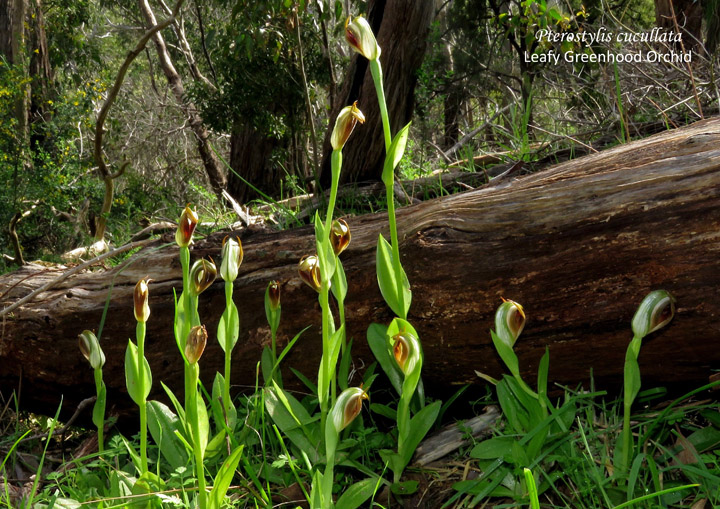
2016 October Photographer: Helen Lawrence
May 2016 Winning Picture

There were four entries this month with two from Western Australia Pauline Meyers’s Caladenia flava and Ros Miller’s Caladenia longicauda sbsp. eminens; one local Greg Sara’s Pheladenia deformis; and one from the Australian Capital Territory, Lorraine Badger’s Cyanicula caerulea. The winner was the Caladenia flava.
If I was to think of an orchid that represents Western Australia it would be hard to choose between the Queen of Sheba and this one.
With its long flowering season (July to December) it is Western Australia’s most common and widespread species; being found in the south west triangle of the state from Kalbarii to Israelite Bay; in habitat as variable as the coastal heathlands through to inland rocky outcrops; from forests to swamp margins. Being so prevalent, it is not surprising that it was amongst one of the first Western Australian orchids collected in September to October, 1791 by the ship-surgeon and naturalist, Archibald Menzies. It was subsequently named in 1810 by Scottish botanist Robert Brown.
C. flava is one of the five species belonging to the subgenus Elevatae. The other four being C. marginata, C. nana, C. reptans (all WA endemics) and C. latifolia which is widespread across southern Australia. All five species have the same characteristic feature of the calli joined together on a raised plate near the base of the labellum. C. flava is distinctively and predominately yellow whereas the others are pink or white.
C. flava has two pollinators, native bees which are lured deceitfully to the non-existent nectar and scarab beetles (Neophyllotocus sp.). As they share the same pollinators, C. flava often hybridizes with C. reptans and C. latifolia, producing very colourful offspring.
Observations have led orchidologists to divide C. flava into 3 subspecies. These differences are based upon floral morphology. but curiously they each have their own separate distribution.
References:
Brown A, et al, 2013 Field Guide to the Orchids of Western Australia
Hopper, SD & Brown, AP 2001b Contributions to Western Australian Orchidology: 2, New taxa and circumscriptions in Caladenia (Spider, Fairy and Dragon Orchids of Western Australia), Nuytsia 14:27–314.
The Role of Orchids
October is Orchid Month with the greatest number of species flowering throughout South Australia; so it is worth considering the role of orchids in the Australian bushland. Hence this week’s blog is an article written by Belinda Newman, Western Australia.
Orchids: The Canary in the Coal Mine was published in the Friends of Kings Park magazine For Plants and People, Issue 70 p 22-24, 2010. The article is both a good introduction to, and summary of, her 2009 thesis Orchids as Indicators of Ecosystem Health in Urban Bushland Fragments
Orchids: The Canary in the Coal Mine
Belinda Newman – Research Scientist BGPA
What could orchids and canaries possibly have in common?
Before occupational health and safety and ventilation systems were commonplace in the mining industry, a caged canary would be bought down to the coal seam by the miners. Canaries are particularly sensitive to methane and carbon dioxide which made them excellent indicators for the build-up of dangerous gases. A singing canary meant everything was fine, a dead canary spelt trouble and an immediate evacuation.
Although orchids can’t sing, they do possess a number of traits that make them sensitive ecological indicators. The relationships that orchids have with their surroundings form part of a complex ecological web. Orchids have specific relationships with mycorrhizal fungi, which they require both for germination of their dust-like seed and ongoing growth of plants in adulthood. These fungi in turn rely on the appropriate soil moisture content and carbon sources. Above ground, the majority of terrestrial orchids in the south west of Western Australia rely on pollinators for successful seed set. For some orchids this plant-pollinator relationship has become so highly evolved that removal of the pollinator would spell the end of the orchid. The pollinators also have specific requirements for habitat, appropriate food sources and nesting sites. These above and below ground links to the ecosystem make orchids particularly sensitive to disturbances and changes in their surroundings.
The potential for orchids to be used as indicators of ecosystem health formed the basis of a study between Kings Park and Botanic Gardens and Murdoch University. The coal seam was eleven urban reserves of varying condition on the Swan Coastal Plain. The canaries were seven orchids common to Perth’s urban bushlands; the Carousel spider (Caladenia arenicola), Cowslip orchid (Caladenia flava), Pink Fairy orchid (Caladenia laitfolia), Pansy orchid (Diuris magnifica), Dark Banded Greenhood (Pteryostylis sanguinea), Purple Enamel Orchid (Elythranthera brunonis) and the Mignonette orchid (Microtis media). Before it was possible to see which orchids made the best canaries, it was important to determine the health of each of the bushland sites. A number of environmental variables were chosen that best reflected the health of the ecosystems. Extensive surveys and analysis of species composition, plant functional groups against these environmental variables revealed a range of site conditions from close to pristine to highly degraded. This provided the backdrop against which to determine the effectiveness of orchids as indicators through the measured responses of the orchid species.
Firstly orchid presence and abundance was measured across sites to determine if particular orchid species showed a preference for particular site conditions. Diuris magnifica and Microtis media showed strong correlations and were most abundant in poor condition sites and Pteryostylis sanguinea showed strong correlations to sites in good condition. While the abundance and presence of orchids appeared to correlate with site condition, we wanted to know what other aspects of the orchid we could measure as a means of judging the health of an ecosystem.
Successful seed set in plants reflects a healthy ecosystem and the reproductive success of the seven orchid species was investigated to determine the effects of declining site condition on seed set. Pollination trials were set up to measure natural and artificial pollination events across all sites. Widespread depression in pollination across all species and sites was found to be occurring, rendering seed set a poor measure of ecosystem health.
Investigations into the below-ground links orchids have with the ecosystem were undertaken by determining the presence and abundance of orchid mycorrhizal for the seven orchid study species across all sites. Mycorrhizal distribution was found to be patchy within urban reserves and also revealed unoccupied niches capable of supporting orchid germination. A greater abundance of Microtis media mycorrhizal at sites of poor condition supported earlier correlations of plant abundance at sites of poor condition. The higher abundance of mycorrhizal symbionts for Caladenia arenicola at sites of very good condition also suggests its potential as an indicator species.
The study also looked at seedling growth in urban reserves. This was the first time that biomass allocation in orchids has been investigated in light of ecosystem health. In poor condition sites, Diuris magnifica and Caladenia arenicola increased growth effort to the above ground leaf. In sites of very good condition, these two species increased growth to the tuber to take advantage of being able to store starch as a result of both fungal and photosynthetic activity taking place. Most importantly this shows a measurable change over a short period time. Although it is effort intensive, planting orchid seedlings of a standardised size into the field may provide a useful and rapid measure of ecosystem health, much like caged canaries were used in the past.
This research into using orchids as an indicator species is the first of its kind and suggests that orchids can be used as an indicator of ecosystem health. Future research will need to focus on the thresholds of the species identified as potential indicators in this study. What aspect of the orchid’s ecology will give clear and repeatable data linked to ecosystem health? Following the canary analogy, how long can orchids hold their breath? Future studies would need to focus on testing these thresholds. The results of this study suggest that orchid presence and abundance, orchid growth and orchid symbionts can be used as indicators of ecosystem health, although work needs to be undertaken to refine the understanding of their response to specific disturbances. This study provides a baseline for investigating the utility of orchids as indicators of ecosystem health in highly fragmented systems. Perhaps orchids and canaries have more in common than first thought.


